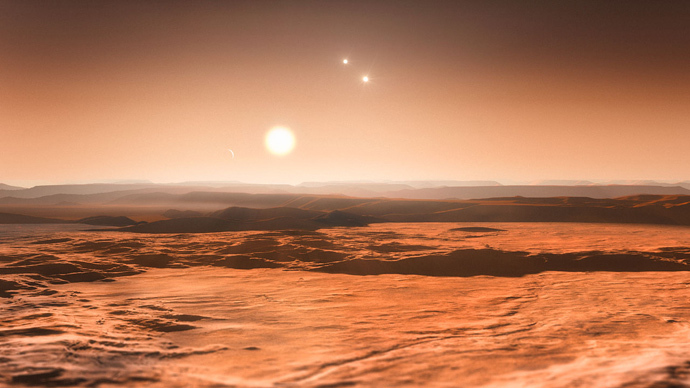Three super-Earths discovered in habitable zone of same star ‘for the first time’

Astronomers have found a record number of super-Earths orbiting in the habitable zone of a known star, 22 light years away from Earth. The planets, which have three suns, have one side illuminated at all times while the other is submerged in darkness.
The Gliese 667C star in the constellation of Scorpion has been well studied before. However, as a result of new observations the scientists made a stunning revelation – instead of three previously known planets the astronomers discovered up to seven, three of which are in the habitable zone of the star where liquid water could exist. All of those three planets are so-called super-Earths.
“This is the first time that three such planets have been spotted orbiting in this zone in the same system,” said one of the authors of the study, Mikko Tuomi of the University of Hertfordshire, UK. "By adding some new observations and revisiting existing data we were able to confirm these three and confidently reveal several more. Finding three low-mass planets in the star's habitable zone is very exciting!"

"These planets are good candidates to have a solid surface and maybe an atmosphere like the Earth's, not something like Jupiter's," said co-author Rory Barnes in a press release issued by University of Washington.
Barnes added that they are located close to each other which "makes it like they are tidally locked,” which in this case means the same hemisphere always faces the star.
"Fortunately, we know that this state can still support life," he said.
Gliese 667C is a low-mass star in a triple star system Gliese 667
located 22 light years away from our Sun. It is the dimmest
star in the system, and it has the habitable zone as “low-mass
stars are intrinsically faint” and cooler. Moreover, this is
the first system found with a fully packed habitable zone,
according to the study which is to appear in the Astronomy &
Astrophysics journal.
The habitable zone of Gliese 667C lies entirely within an orbit the size of Mercury’s around the Sun.
"Super-Earths" are planets located within their star’s habitable zone, more massive than the Earth but less massive than Uranus and Neptune which are both approximately 15 Earth masses.
Planets within the star’s habitable zone are also called
Goldilock planets. The three potentially habitable
planets of this system are expected to always have the same side
facing the star, so that their day and year will be the same
lengths, with one side in perpetual sunshine and the other always
night.
Viewed from these newly found three planets, the other two suns in the system would look like a pair of very bright stars visible at the daytime, and at night they would illuminate the planets as the full Moon illuminated the Earth, the study says.
“The number of potentially habitable planets in our galaxy is much greater if we can expect to find several of them around each low-mass star — instead of looking at ten stars to look for a single potentially habitable planet, we now know we can look at just one star and find several of them,” adds co-author Rory Barnes.
Similar systems have been found before, however, most them were centered around stars which are too hot to be habitable.













